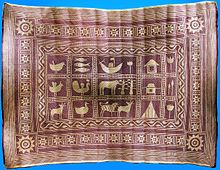


Sheetal Pati Self Weaving
| |
| Type | Carpeting |
|---|---|
| Material | Murta plants fiber |
| Production method | Weaving |
| Production process | Handicraft |
| Place of origin | Bangladesh |
| Traditional art of Shital Pati weaving of Sylhet | |
|---|---|
| Country | Bangladesh |
| Domains | Traditional craftsmanship |
| Reference | 01112 |
| Region | Asia and the Pacific |
| Inscription history | |
| Inscription | 2017 (12th session) |
| List | Representative |
| Part of a series on the |
| Culture of Bangladesh |
|---|
 |
|
|
|
|
|
|
|
|
|
|
|
|
|
|
|
|
|
|
|
Music and performing arts
|
|
|
|
|
|
Monuments |
|
|
|
|

Sitalpati (Bengali:শীতল পাটি), also called sital pati and sittal pati, is a kind of mat which feels cold by nature. It is made from murta plants (Schumannianthus dichotomus). It is usually used in Bangladesh (and to a lesser extent, India's West Bengal). Mats with decorative designs are called nakshi pati.[1]
Sitalpati are made from cane or from murta plants, known in different places as mostak, patipata, patibet and paitara. The murta plant grows around water bodies in Sylhet, Sunamganj, Barisal, Tangail, Comilla, Noakhali, Feni and Chittagong. Nakshi pati made of murta plants is available only in Sylhet and Noakhali districts of Bangladesh. In India, Sitalpati is made in the northern Cooch Behar district of the state of West Bengal. Among the areas of Cooch Behar where Sitalpatis are woven, Sagareswar, Ghugumari and Pashnadanga are important centres. [2]

UNESCO has recognised the Traditional Art of Shital Pati weaving of Sylhet and included it in the Representative List of the Intangible Cultural Heritage of Humanity.[3]
| Part of a series on the |
| Culture of Bengal |
|---|
 |
| History |
|
|
|
|
|
Traditions |
|
Mythology and folklore
Myths
Lores |
| Cuisine |
|
Festivals |
|
Art |
|
Genres Institutions Awards |
|
Music and performing arts Folk genres Devotional Classical genres Modern genres People Instruments Dance Theater Organizations People |
|
Media |
|
Sport |
|
|